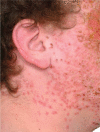Advances in atopic dermatitis
- PMID: 34001568
- PMCID: PMC8140689
- DOI: 10.7861/clinmed.2021-0280
Advances in atopic dermatitis
Abstract
Atopic dermatitis (AD) is a common inflammatory skin disease characterised by itch and is responsible for significant reduction in quality of life. While AD primarily arises in those under the age of 2 years, it is frequently persistent into adulthood. Recognition of AD is important for the general physician, especially to distinguish causes of acute flares that may present in any medical setting, such as eczema herpeticum and associated allergic reactions. While, to date, treatments have largely focused on broad spectrum immunomodulation with corticosteroids or systemic therapies (such as ciclosporin and methotrexate), increased knowledge in the pathophysiology of the disease has recently led to the expansion of treatment options available for those suffering with AD, and the new drugs on the horizon promise a previously unimagined potential for effective and safe treatment.
Keywords: JAK inhibitors; atopic eczema; dermatitis; dupilumab.
© Royal College of Physicians 2021. All rights reserved.
Figures




Comment in
-
Probiotics for atopic dermatitis.Clin Med (Lond). 2021 Jul;21(4):e430. doi: 10.7861/clinmed.Let.21.4.8. Clin Med (Lond). 2021. PMID: 35192499 Free PMC article. No abstract available.
References
-
- Williams HC, Burney PG, Pembroke AC, Hay RJ. The UK working party's diagnostic criteria for atopic dermatitis. Br J Dermatol 1994;131:406–16. - PubMed
-
- Gawkrodger DJ, Ardern-Jones MR. Dermatology: an illustrated colour text, 6th Edn. Elsevier, 2017.
MeSH terms
Substances
LinkOut - more resources
Full Text Sources
Other Literature Sources
Medical
Research Materials

